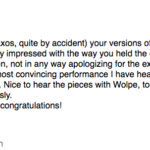
My album “Invisible Colors” was released a few months ago in the USA by Urlicht Audiovisual. I play pieces by Carter, Wolpe and Ferneyhough. There haven’t been many reviews but I much enjoyed making it and spending some time venturing into the “complexity” byways and absorbing the restless, super-layered qualities of it all. It’s gotten some wonderful feedback. Recently, I received this email from Brian Ferneyhough, out of the blue (posted above). I was very excited, especially since I’d never (still haven’t) met or spoken with him before.
It was also very interesting to find recently this note by him about that piece:
I have always been fascinated by the sometimes problematic but always stimulating parallels between musical and non-musical modes of cognition. In the same spirit, the titles of my works are not infrequently selected with a view to throwing at least a little light on the limits and nature of the specific discursive models involved. In many surrealist paintings the title stands in a strikingly fractured or discrepant logical relationship to the image, thereby sensibilising the observer to the unseen presence of a complex field of semantically active energies. According to one of Marcel Duchamp’s most celebrated pronouncements, the title of a painting thus assumes the status of an “invisible colour”, that of the imagination, amplifying and enriching our subliminally speculative perceptions somewhere beyond the limits of the ocularly accessible spectrum. In the case of this short composition for violin it seemed fitting that the various degrees of “invisibility”, absence or erasure involved in the compositional process should be evoked by means of a title itself suffering from radical strategic incertitude at one degree remove. In a sense, Unsichtbare Farben might be seen as the “tip of the iceberg”, to the extent that the vast preponderance of materials that went into its preparation appears nowhere in the musical phenomenon itself, having been suppressed by a formal filtering operation selecting and interleaving structurally equivalent elements from a relatively large number of through-composed layers. Correspondingly, the unfolding of the work’s argument is characterised primarily by a series of rhetorical ruptures as short fragments of otherwise impalpable processes are abruptly invoked and, equally suddenly, abandoned.
